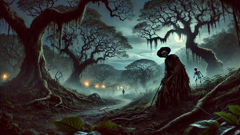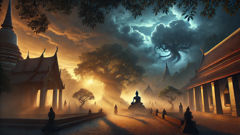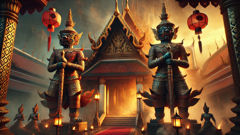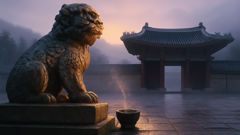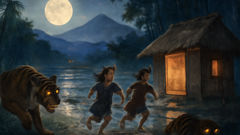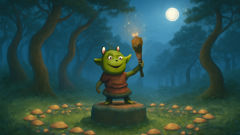Introduction
Every remote corner of Brazil carries its own weight of stories, but none as chilling and persistent as the legend of the Corpo-Seco, the Dried Corpse. Whispered from generation to generation, this tale is not just a ghost story—it’s a warning, a memory of darkness rooted in the red earth and tangled forests of Minas Gerais. In villages bordered by sugarcane fields and beneath the heavy canopies of ancient jacaranda trees, the old folks gather at dusk, their eyes darting to shadowed windows, their voices low. It is during those hushed hours, as the sun sinks and the world holds its breath, that they speak of the man whose wickedness outlived his flesh, a man so irredeemable that not even the forgiving earth would welcome his bones. The legend wraps itself around the land like a creeping vine, its roots tangled with the history of cruelty, superstition, and the unrelenting quest for peace in a world haunted by its own past. Here, in a time before the railway cut through the wild, in an age when faith was measured by candlelight and the toll of church bells, the story begins—with terror, regret, and the inescapable presence of the Corpo-Seco.
The Making of a Monster
In the mid-1800s, the village of São Gregório nestled between rolling hills and dense forests was a place untouched by progress but marked by an ancient sense of order. Life followed the cycles of planting and harvest, the tolling of the chapel’s bell, and the arcane rhythms of superstition that stitched together the community’s fragile peace. Among its humble inhabitants, none was more feared or despised than Antônio das Mortes, a name spoken only with caution.
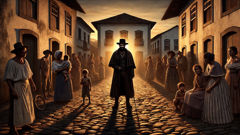
Antônio was born under a cloudless sky, but his soul seemed darkened from the first cry. From a young age, his eyes bore a strange hollowness, and his hands, always restless, found their purpose in cruelty. He tormented animals, bullied smaller children, and mocked the elderly, his laughter echoing with a chill that clung to the skin. As he grew, so did his capacity for violence. No one in São Gregório could recall a single act of kindness from him—his father’s land was worked by others, his mother’s prayers were met with sneers, and his neighbors’ pleas for mercy only fed his appetite for suffering.
Despite his wickedness, Antônio possessed a cunning that kept him just out of reach of the law and the parish priest. Rumors swirled like the morning mists: they said he trafficked with dark spirits, that he sold stolen cattle to bandits who slipped silently through the night, and that he hid treasures and secrets in the abandoned chapel ruins on the hill. Yet nothing could be proven. The villagers avoided his path, crossing themselves as he passed, hoping his gaze would not linger. For all their fear, they watched helplessly as he grew older, meaner, and more entrenched in his ways.
It was not long before Antônio’s crimes crossed the final line. One moonless night, driven by greed and malice, he set fire to the barn of a rival farmer, trapping a family inside. The flames devoured wood, hay, and flesh alike. The cries of the dying haunted the village for years, but Antônio’s heart remained untouched, his expression as blank as parched earth. The villagers gathered in the plaza at dawn, demanding justice, but Antônio vanished into the woods before they could seize him. For weeks, São Gregório trembled under a shadow, waiting for retribution or release.
Antônio’s end came not by the hand of justice, but by an accident as senseless as his life had been. Fleeing through the forest, he slipped on a moss-slicked stone near the ravine, his body tumbling down to rest in a thicket of thorns. Alone and broken, he died without confession, without forgiveness, his last breath a curse on the world that had never bent to his will.
When news of his death reached the village, the relief was palpable, but dread soon replaced it. The question lingered: what would become of such a man’s soul? The villagers prepared his burial with haste and fear. The priest, trembling, refused to perform a proper mass. As Antônio’s body, already stiff and shriveled, was lowered into the ground, a silence heavier than stone settled over São Gregório.
But peace would not come so easily. That night, as the mourners returned to their homes and locked their doors against the darkness, a violent wind swept through the village. The next morning, Antônio’s grave was found clawed open from within—the earth scattered, the coffin splintered, and the corpse gone. Panic rippled through São Gregório. Children were kept indoors, doors were bolted tight, and prayers rose like smoke to the indifferent sky.
In the following days, strange occurrences plagued the village. Livestock was found dead, their bodies twisted in unnatural shapes. Dogs howled at empty crossroads. Whispers spread of a gaunt figure, more shadow than flesh, stalking the forest’s edge. Some said they glimpsed a dried, blackened hand pressing against their window at night. The legend grew: Antônio had become something beyond death—Corpo-Seco, the Dried Corpse, doomed to wander for eternity, a punishment befitting his evil.
The Haunting and the Hunt
For months after the disappearance of Antônio’s corpse, São Gregório lived in perpetual fear. The villagers spoke in whispers, avoiding the woods at dusk, and many hung protective amulets above their doors. The priest organized nightly prayers, candles burning late into the night as if their light alone could keep evil at bay. Yet nothing could dispel the chill that crept into every home.

The stories multiplied: travelers who strayed too close to the forest’s edge vanished without a trace; pale faces peered from windows as something scratched at doors in the dead of night. The bravest among them—hunters hardened by years in the wild—ventured out to find the cause. They returned, silent and shaken, unable to explain the tracks like twisted roots pressed into the mud, or the patches of grass turned black as if scorched by some unnatural fire.
One evening, as a blood-red moon rose over the horizon, João Batista, the village’s eldest and most respected man, decided that action was needed. He gathered a small band of villagers—men and women alike, each bearing torches, machetes, and an ancient faith in the power of unity. As they entered the forest, silence wrapped around them like a shroud, broken only by the crunch of dead leaves and the occasional hoot of an owl.
The search was tense, each shadow a potential hiding place for the Corpo-Seco. Then, near the ravine where Antônio had met his end, they found it—a figure hunched against the trunk of an ancient tree, its skin pulled taut over bones, eyes sunken and burning with a fevered light. The creature’s movements were stiff, unnatural, each limb jerking as if pulled by invisible strings. It reeked of decay and earth, but its gaze was alive with malice. João raised his torch, and for a moment, the flames flickered in the dried hollows of the Corpo-Seco’s face. Without a sound, the creature vanished into the undergrowth, moving faster than any living thing should.
Panic gripped the group, but João steadied them. He recalled the old stories—the only way to halt a Corpo-Seco was to trap it with sacred words or drive it away with pure iron. They formed a circle, chanting prayers as they slowly retreated toward the village. The creature followed at a distance, its silhouette flickering between the trees, but never crossing the line of light cast by their torches.
That night, João called an emergency meeting in the chapel. The villagers debated, argued, and wept. Some wanted to flee; others insisted on fighting. In the end, it was decided: they would confront the Corpo-Seco with faith, unity, and the symbols of their heritage—crucifixes, iron tools, holy water blessed by a priest brought from a neighboring town.
The next days were spent preparing. The villagers reinforced their homes, mapped out patrols, and trained the young in the ancient prayers handed down from their ancestors. João led these efforts with a grim determination. Despite the terror, a flicker of hope began to kindle in their hearts. Maybe, just maybe, they could drive the evil back into the shadows from whence it came.
But the Corpo-Seco would not be banished so easily. Each night it prowled closer, testing their defenses. Chickens were found drained of blood. Fruit withered on the vine overnight. The air itself grew colder, and fog lingered long after dawn. The villagers clung to their rituals, but exhaustion and despair gnawed at their resolve. One by one, their faith began to falter, and with every crack in their unity, the power of the Corpo-Seco seemed to grow.
The Reckoning and Redemption
As the weeks dragged on, São Gregório stood on the brink of collapse. The villagers’ hope faded with every failed attempt to banish the Corpo-Seco. Nightly patrols dwindled as exhaustion and terror claimed more hearts. Even João Batista, once a pillar of strength, felt his faith begin to crack beneath the weight of constant dread. The legend of the Corpo-Seco had become more than a story—it was now an ever-present shadow, suffocating the land.
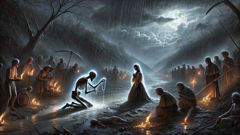
One night, as a storm raged across the valley, lightning illuminating the jagged peaks and thunder shaking the very foundations of their homes, a desperate plan took shape. Maria do Carmo, a young woman whose brother had vanished in the woods weeks before, approached João. She spoke with conviction that startled him—a belief that perhaps the only way to end the curse was to confront its source not with violence, but with compassion.
Maria gathered what few dared join her—a handful of villagers and a priest from a distant parish—and set out for the ravine where Antônio had died. The storm lashed at them, rain slicing through the trees and turning the earth to mud. Still, they pressed on, guided by faith and desperation.
When they reached the ravine, Maria stood at its edge and called out into the darkness. Her voice carried above the wind, repeating prayers not for protection, but for forgiveness—for Antônio das Mortes and for themselves. For a moment, nothing answered but the howl of the storm. Then, from between two twisted trunks, the Corpo-Seco emerged, drawn by the unfamiliar sound of compassion.
The creature was a wretched sight: skin like cracked leather stretched over sharp bones, eyes burning with an ancient anguish. Yet as Maria knelt and spoke words of mercy, something shifted in its posture. The others joined her, their voices trembling but resolute. The priest sprinkled holy water and recited prayers for the dead. Slowly, impossibly, the storm quieted.
In that unnatural calm, the Corpo-Seco staggered forward, arms outstretched. Maria did not flinch. She pressed a rosary into its shriveled hand and whispered a prayer. The villagers stood in a circle of torchlight, their faces illuminated with a strange mixture of fear and hope. The creature let out a sound that was half-sob, half-roar, collapsing to its knees.
Then, with a final flash of lightning, the air filled with the scent of earth after rain. The body of the Corpo-Seco crumbled, dissolving into dust that was swept away by the wind. Where it had knelt, a single white flower bloomed—an impossible symbol of peace in that haunted place.
The villagers returned to São Gregório forever changed. Some doubted what they had witnessed; others believed it was a sign that even the darkest soul could be granted rest. The tale of Corpo-Seco became a lesson not just in fear, but in redemption—a warning and a hope woven together.
Years passed. The forests reclaimed the ravine, wildflowers blooming each spring where once only darkness dwelled. The legend endured in stories whispered around hearths: a reminder of evil’s power, but also of forgiveness—the one force that even death cannot deny.
Conclusion
The legend of the Corpo-Seco still lingers in Brazil’s rural heartlands, where old trees remember and rivers murmur secrets to those who listen. It’s a tale that speaks not only of terror but of the heavy burden of evil and the possibility of redemption—however unlikely it may seem. Generations have learned to heed its warnings: that cruelty sows seeds deeper than any grave, and that sometimes the land itself rejects what cannot be forgiven. But there is another lesson too—one whispered by elders and echoed in the prayers of children—that even the most lost soul may one day find rest if met with courage and compassion. In São Gregório, wildflowers bloom every spring where darkness once ruled, and the villagers light candles not just for protection but as beacons of hope for wandering spirits and living hearts alike.

